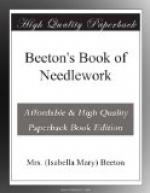ILLUSTRATION 232 (Raised Spots).—The grounding on which these spots are worked consists of double crochet. They are worked across 3 rows of the ground, and formed of treble stitches, the spots of one row being placed between those of the preceding. Work first 2 rows of double stitch, in the 3rd row work first 2 double stitches and then 1 spot as follows:—1 treble, inserting the needle into both sides of 1 stitch of the first row (the preceding row is missed); the treble stitch is only completed so far that 2 loops remain on the needle; then work 2 treble stitches in the same stitch as the first, which are also only completed as far as the first treble stitch, so that after the 2nd treble there remain 3 loops and after the 3rd 4 loops on the needle (see illustration). The 4 loops are cast off together by winding the cotton once more round the needle and drawing it through. Miss under the spot the next double stitch of the preceding row; the spots are repeated at intervals of 5 stitches and in every other row.
[Illustration: 233.—Hollow Spots.]
ILLUSTRATION 233 (Hollow Spots).—The ground is worked in double crochet (illustration 220). These spots, which appear raised, consist of 5 treble stitches; they are worked in every other row at intervals of 5 stitches. For working them leave 1 loop on the needle, insert the needle between the 2 long sides of the last-worked double stitch, and work 5 treble stitches, always inserting the needle into the front part of 1 stitch of the preceding row. The first 4 treble are completed entirely without taking up the loop which was on the needle; with the fifth treble stitch only the 3 loops are cast off together by winding the cotton round the needle. Miss 1 stitch of the preceding row under the spot.
[Illustration: 234.—Open-work Spots.]
ILLUSTRATION 234 (Open-work Spots).—These spots are treble stitches divided by 2 chain; miss 2 stitches under the latter; for the rest, they are worked like the raised spots (illustration 232).
[Illustration: 235.—Raised Treble Stitch.]
ILLUSTRATION 235 (Raised Treble Stitch).—These stitches are long treble worked on a ribbed ground (illustration 222), and are thrown across 3 rows of the same. The raised treble are always worked on the same side of the work and in the long side of the corresponding stitch of the last row but two. After every row with treble stitch comes a row in ribbed stitch. At the beginning work 3 rows of ribbed stitch; the treble stitches begin only in the 4th row.
[Illustration: 236.—Purl Stitch.]
ILLUSTRATION 236 (Purl Stitch).—These purl stitches imitate a lace edging perfectly well. Work 1 double, draw out the loop to a certain length (this forms the purl), take the needle out of it, insert it in the front part of the last stitch which has been worked (see illustration), wind the cotton round the needle and draw it through as a loop; 1 double, 1 purl, and so on.




